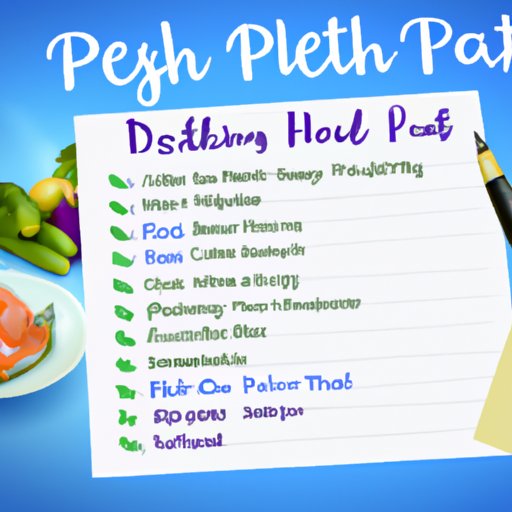Introduction
A pescatarian diet is essentially a vegetarian diet that includes fish and seafood. It is an increasingly popular lifestyle choice for those looking for a healthier way to eat. This article will explore the health benefits of a pescatarian diet, as well as provide tips on how to start your own journey with this diet.

Research the Health Benefits of a Pescatarian Diet
The health benefits of a pescatarian diet are numerous. A pescatarian diet is nutrient-dense and provides essential vitamins and minerals. Additionally, it is high in healthy proteins and omega-3 fatty acids, which can help reduce inflammation and support heart health.
In addition to its nutritional advantages, a pescatarian diet also has environmental benefits. Eating more plant-based foods and fewer animal products means less water and energy used in production, and less pollution generated. Furthermore, fish consumption can be sustainable, as long as it is sourced from responsible fisheries.
However, it is important to note that there are potential health risks associated with a pescatarian diet. Some fish and seafood contain high levels of mercury, which can be harmful if consumed in large amounts. Additionally, some types of fish may contain other contaminants such as PCBs, so it is important to research the types of fish you are consuming and make sure they are sustainably sourced.
Understand What Foods are Allowed on a Pescatarian Diet
A pescatarian diet typically includes fish and seafood, vegetables, fruits, dairy products, whole grains, legumes, nuts and seeds. Here is a breakdown of the different food groups and their associated health benefits:
Fish and Seafood – Fish and seafood are rich sources of protein, omega-3 fatty acids, B vitamins, iron, zinc, and selenium. They are also low in calories and saturated fat. Eating a variety of fish and seafood ensures you get a wide range of nutrients.
Vegetables – Vegetables are packed with vitamins, minerals, fiber, and antioxidants. Eating a variety of vegetables ensures you get the most nutritional benefits. Dark leafy greens and cruciferous vegetables such as broccoli and cauliflower are particularly nutritious.
Fruits – Fruits are excellent sources of vitamins, minerals, fiber, and antioxidants. Eating a variety of fruits ensures you get a wide range of nutrients. Berries, citrus fruits, and melons are especially nutritious.
Dairy Products – Dairy products are rich sources of calcium, protein, and other essential nutrients. However, some people may choose to limit or avoid dairy due to dietary restrictions or allergies. If you do consume dairy, opt for organic and grass-fed options, as these are higher in nutrients.
Whole Grains – Whole grains are packed with fiber, vitamins, minerals, and antioxidants. Eating a variety of whole grains ensures you get the most nutritional benefits. Quinoa, oats, and brown rice are especially nutritious.
Legumes – Legumes are excellent sources of protein, fiber, vitamins, and minerals. Eating a variety of legumes ensures you get the most nutritional benefits. Lentils, chickpeas, and black beans are particularly nutritious.
Nuts and Seeds – Nuts and seeds are rich sources of healthy fats, protein, fiber, vitamins, and minerals. Eating a variety of nuts and seeds ensures you get the most nutritional benefits. Almonds, walnuts, and chia seeds are especially nutritious.

Create a Shopping List of Approved Foods
Once you have researched the health benefits of a pescatarian diet and understand what foods are allowed, it is time to create a shopping list. Make a list of all the necessary groceries, including fresh produce, fish and seafood, dairy products, whole grains, legumes, nuts, and seeds. Consider buying organic and sustainable options when possible, as these are higher in nutrients and better for the environment.
Make Meal Plans and Recipes
Once you have your shopping list, it is time to make meal plans and recipes. Plan out meals for the week, focusing on utilizing the approved foods. Find recipes that utilize the approved foods, as well as experiment with different cuisines. The internet is a great resource for finding pescatarian recipes, so take advantage of this.
Find Supportive Resources and Community
Starting a pescatarian diet can be daunting, but there are many supportive resources available. Join online groups to connect with others who are also following a pescatarian diet. Connect with pescatarian chefs and bloggers who can provide valuable advice and inspiration. Read books and articles on pescatarianism to further your knowledge of the diet.

Gradually Transition to the New Diet
When transitioning to a pescatarian diet, it is important to take it slow. Gradually cut out non-pescatarian foods and incorporate more fish and seafood into meals. Focus on enjoying the process and discovering new flavors and recipes. Don’t be discouraged if you slip up; just keep at it and you will eventually reach your goals.
Conclusion
A pescatarian diet offers numerous health benefits, including increased nutrient intake and reduced environmental impact. To start your journey with this diet, research the health benefits, understand what foods are allowed, create a shopping list, make meal plans and recipes, find supportive resources, and gradually transition to the new diet. With dedication and patience, you can reap the rewards of a pescatarian lifestyle.
(Note: Is this article not meeting your expectations? Do you have knowledge or insights to share? Unlock new opportunities and expand your reach by joining our authors team. Click Registration to join us and share your expertise with our readers.)
